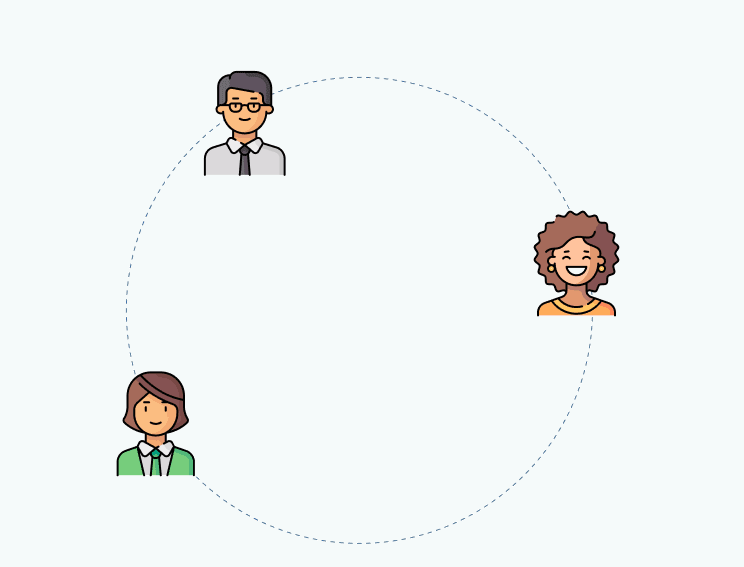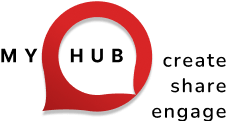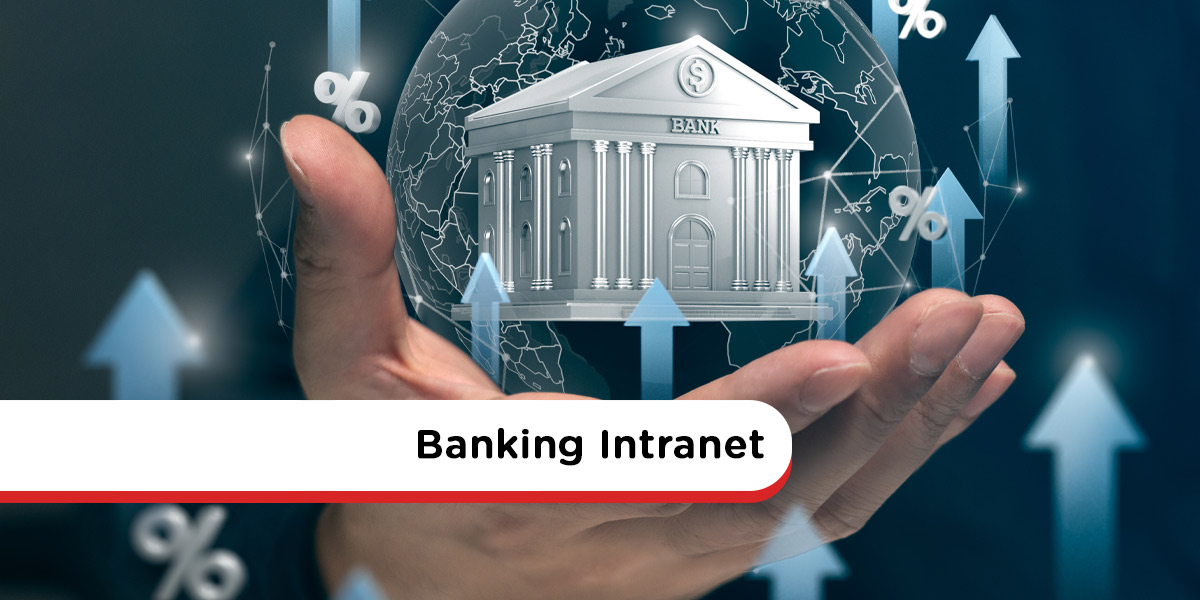
Your New Intranet Starts Here
Streamline communication, boost collaboration, and empower your team with MyHub's intuitive intranet solution.
Book a live demo now and experience the difference.
Take a Quick TourLike any company, banks and financial institutions need advanced technology to support essential business functions like internal communications and knowledge sharing. However, financial organizations face unique challenges, with security and compliance at the very top of the list. A banking intranet is the perfect solution. It combines robust security features with seamless collaboration tools and streamlined processes to boost productivity and deliver better customer service.
What Are Banking Intranets?
Banking intranets are private, secure networks used by financial institutions to improve internal communication, teamwork, and information sharing across the organization.
While some institutions still build intranets from scratch and host them on-premise, most modern solutions are cloud-based intranets managed by specialist providers. Cloud hosting reduces IT overheads, speeds up deployment, and ensures automatic security updates.
Because sensitive data is the daily currency of banks, financial intranets come with built-in safeguards. Features like SSL encryption, access controls, and multi-factor authentication create a highly secure digital workplace that protects both employee and customer information.
Benefits Of An Intranet For Banks
Whether you are a bank, credit union, or another type of financial services provider, an intranet delivers a fully integrated platform with a wide range of benefits:
- Improve internal communication and collaboration across departments
- Enhance employee engagement, knowledge sharing, and organizational learning
- Boost productivity and efficiency in daily operations
- Support compliance, governance, and data control requirements
- Provide a single centralized platform for information sharing and access
- Enhance customer service by giving staff quick access to accurate information
In short, intranets connect employees and provide the resources they need under one secure virtual roof. Modern intranets also integrate with enterprise systems such as HR and payroll apps, CRMs, and accounting platforms. With single sign-on, employees enjoy seamless access to multiple tools, removing the frustration of toggling between systems.
Suggested Use Cases For Your Intranet Software
Every financial institution has different priorities. Here are some common intranet use cases that deliver measurable impact.
Boost Employee Engagement
Challenges: The financial sector is fast-paced and high-pressure. Tight deadlines, compliance demands, and heavy workloads can affect morale. Engagement is even harder to maintain with many remote and hybrid employees, recent statistics show that 61% of full-time finance employees and 25% of part-time staff work remotely.
Solution: A bank intranet helps organizations strengthen engagement by:
- Supporting two-way communication through team chat, news feeds, and dedicated channels
- Gathering feedback from employees via blogs, surveys, and snap polls
- Recognizing employee contributions with shout-outs, leaderboards, or rewards (research by Gallup confirms recognition boosts productivity)
- Delivering training and development through mentoring, webinars, and certification programs
Knowledge Management for Financial Organizations
Challenges: Financial institutions generate huge volumes of data daily. From customer records to compliance updates, employees can easily feel overwhelmed. Information often exists in silos across departments, making it hard to find what’s needed quickly.
Solution: A centralized knowledge management system within your intranet ensures employees have a single source of truth. Policies, procedures, and regulatory updates can be stored, categorized, and version-controlled, reducing duplication and confusion.
- Build a searchable knowledge base with relevant resources
- Use tagging and categories for quick discovery
- Encourage employees to contribute expertise and share best practices
- Provide access to industry insights and compliance updates
- Improve customer service by giving staff instant access to reliable information
Data Control and Compliance
Challenges: Whether it’s GDPR, GLBA, or other financial regulations, compliance is a moving target. Effective data governance requires clear policies, consistent procedures, and strong employee adoption to safeguard sensitive financial data.
Solution: A secure intranet enhances compliance with centralized updates, secure communication channels, and access controls. Employees always have the latest guidance, reducing risks of breaches or non-compliance.
Key features include:
- Automated data retention and deletion policies
- Workflows designed around regulatory compliance
- Role-based access controls to protect sensitive data
- Monitoring and auditing tools to track user activity
How To Plan and Design A Banking Intranet
Ready to take the next step? Getting started on your financial intranet is simple with our proven four-step process designed for banks, credit unions, and other financial institutions.
1. Define Goals and Objectives
Defining your intranet goals and objectives is the essential first step. What challenges is your bank facing that the intranet should solve? For example, it could be enhancing internal communication, centralizing compliance documents, or streamlining workflows. Having clear objectives ensures you select the right features, such as knowledge management, document sharing, or workflow automation.
2. Choose The Right Platform
With goals defined, the next step is selecting the best banking intranet platform. Research vendors carefully, there are many options in the market. Look for a solution that offers user-friendly design, scalability, strong security measures, and smooth integrations with your existing systems. Also, evaluate the customer support on offer. In financial services, you need a responsive provider who can resolve issues quickly and reliably.
3. Evaluating Intranet Solutions
By now, you should have a shortlist of contenders. To properly evaluate solutions, request free demos or trial accounts. This gives your team the chance to test usability, features, and mobile access. Also, consult independent review sites for unbiased feedback from other financial organizations. The ideal platform will offer intuitive navigation, powerful search, personalized updates, and a secure, mobile-friendly interface for staff in branches or working remotely.
4. Implement And Train
Implementation doesn’t have to be complex. Fully customizable, pre-built intranet templates make setup fast and efficient, a huge advantage in the fast-moving financial sector. Once live, invest in comprehensive staff training. When employees feel confident using the system, adoption rates soar, and your bank maximizes the return on its investment.
Key Features for Banking Intranets
Still unsure about the right intranet? To help, here’s a list of the most important intranet features for banks and credit unions:
- Central Knowledge Hub: A single source of truth for product updates, compliance guidelines, policies, and procedures.
- Digital Forms And Workflows: Streamline operations with faster, automated processes that reduce manual errors and improve service delivery.
- Personalized Updates: Tailored feeds keep employees at every level, from head office to branch, aligned with relevant news and announcements.
- Employee Directory: An interactive directory makes it easy to find colleagues across multiple branches, boosting collaboration and saving time.
- Document Management: Ensure proper version control and seamless teamwork with secure document storage and sharing.
- Advanced Security: Protect sensitive financial data with enterprise-grade security, including encryption, MFA, access controls, and regular audits.
Financial Institution Intranets: Real-World Case Studies
Real-world examples show how banks and credit unions benefit from modern intranet solutions:
Louisiana-based JD Bank replaced outdated systems with a centralized intranet. The platform improved access to critical business systems, policies, and forms, while also fostering a stronger corporate culture with employee-driven news and events.
Farm Bureau Bank introduced a social intranet called The Insider. Originally for top-down communication, it quickly became a hub for collaboration and culture-building with features like employee recognition and a virtual water cooler.
Canada’s DUCA Financial Services Credit Union modernized its outdated intranet to improve communication across branches. The new platform delivered interactive tools, better usability, and improved employee engagement, resulting in more efficient operations.
Intranet For Banks: Key Takeaways
When it comes to improving efficiency and employee engagement, banking intranet solutions are hard to beat. Under one digital roof, banks can centralize tools and resources that empower employees, streamline compliance, and deliver faster, more responsive services to customers. It’s a win-win, better employee experience and stronger customer satisfaction.
About MyHub
MyHub’s financial intranet software is designed to meet the unique needs of banks and credit unions. Easy to set up and manage, it includes mobile access so employees can stay connected on the go. With over 60 enterprise integrations, pre-built templates, team chat, and personalized feeds, MyHub makes it simple to create an engaging, secure, and productive intranet for your organization.
Discover more with a free demo or start your 14-day no-obligation trial.
FAQ Section
What makes a banking or finance intranet different from a generic intranet?
A banking/finance intranet emphasizes advanced security, rigorous compliance, centralized management of policies and financial data, role-based permissions, and integrations with financial/regulatory tools—beyond what many generic intranets offer.
Which features are essential for a finance intranet to be truly effective?
Key features include document and version control, digital workflows (forms and approvals), strong search, mobile access, employee engagement tools (news feeds, shoutouts, feedback), security measures (MFA, permissions), and integration with enterprise systems.
How do you ensure user adoption and success after launching a finance intranet?
Start by setting clear goals, choosing a user-friendly platform, training staff, providing ongoing support, collecting feedback, and measuring performance using analytics to refine and improve. Ensuring compliance and keeping data current also help maintain trust and usage.



